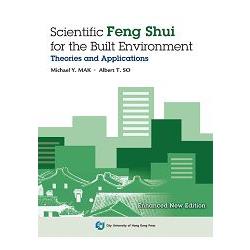Scientific Feng Shui for the Built Environment:Theories and Applications(Enhanced New Edition)
-
7折 669元
955元
-
 預計最高可得金幣30點
?
可100%折抵
預計最高可得金幣30點
?
可100%折抵
活動加倍另計 -
HAPPY GO享100累1點 4點抵1元折抵無上限
- 作者: Michael Y Mak- Albert T So 追蹤
- 出版社: 城市大學 追蹤 ? 追蹤出版社後,您會在第一時間收到出版社新書通知。
- 出版日:2015/03/01
內容簡介
Modern architecture has become increasingly concerned about the integration and harmony between the natural and built environments. Terms like environmental protection and management, energy conservation, renewable energy, sustainability and ecology have been pouring into our ears on a daily basis. In fact, all these concepts are not new from an ancient Chinese point of view; Feng Shui or more academically, Kan Yu, is exactly the traditional Chinese wisdom aimed at creating harmony between the environment, buildings and people.
Feng Shui is the philosophy which has influenced traditional building design in China for thousands of years. Based on Scientific Feng Shui for the Built Environment: Fundamentals and Case Studies published in 2011, this enhanced new edition has further taken into account the enhancements and new inputs in theories and applications. Emphasis is placed on two themes, sustainability and science. New case studies regarding sustainable design as viewed from a Feng Shui perspective, and integrated applications of different architectural models and their associations with Feng Shui concepts are added and elaborated. On science, other than exploring the new development of particle physics in relation to Feng Shui studies, a totally new approach to numerology and Luo Shu study based on modern linear algebra may bring readers new insight into the possibility of researching Feng Shui mathematically, in addition to the use of spherical trigonometry.
This book offers a remarkable in-depth view of Feng Shui by integrating the historical theories with scientific explorations and examples of applications. It once again demonstrates that Feng Shui can be studied scientifically, and eventually scientific Feng Shui may become a new field of science in the academic world as well as a professional and orthodox discipline of architectural design for the built environment.
目錄
1. Introduction
PART A Scientific Feng Shui
2. Science and Feng Shui
3. Scientific Methods and Feng Shui Study
4. Studying Feng Shui
5. The Development of Feng Shui
PART B Form School Approach
6. Culture and Architecture
7. Theories of the Form School
8. Form School Practice in the Built Environment
9. Conceptual Framework for the Form School Approach
10. Case Studies: Feng Shui Villages in Hong Kong
11. Case Studies: Sustainable Design and Feng Shui
12. Case Studies: Feng Shui Integrated Applications for Built Environment Analysis
PART C Compass School Approach
13. Numerology and the Compass School
14. The Luo Shu and the Modern Linear Algebra
15. Modern Physics and the Compass School
16. Theories of the Compass School
17. The Method of Eight Mansions
18. The Method of Flying Stars
19. Case Studies: Applications of the Compass School
20. Case Studies: Applications of Shared Guas
21. Conclusion
序/導讀
Preface
Readers may have read in our book, Scientific Feng Shui for the Built Environment: Fundamentals and Case Studies, published four years ago, that both Chinese and western cultures have always contemplated the harmony between the mankind and our surrounding environment; the natural environment in ancient times, and the built/natural environment today. Modern architecture has become increasingly concerned about the integration and harmony between the natural and built environments as "green living" seems to be the hottest contemporary topic. Terms like environmental protection and management, energy conservation, renewable energy, sustainability and ecology etc. have been pouring into our ears on a daily basis. In fact, all these concepts are not new from an ancient Chinese point of view; this study in the past was called Feng Shuior Kan Yu more academically, a traditional Chinese wisdom aimed at creating harmony between the environment (both referring to the sky and the earth), buildings and people. It is a philosophy which has influenced traditional building design in China for thousands of years.
In the western world, the popular conception of Chinese Feng Shuiis the practice of doing the right thing at the right place, at the right time and with the right style. The original ancient Chinese term for this study was Kan Yu; the term Feng Shuiis (in Chinese historical terms) a relatively recent nomenclature. ôKanö refers to the observations of sky and climate and ôYuö refers to investigations of the landscape and geography. The expression "Feng Shui" was first used in the classic text The Book of Burial published in the Jin Dynasty, some 1,700 years ago. In direct translation, "Feng" simply means wind while "Shui" means water. Our books could certainly tell you the scope of Feng Shuiis much broader, in terms of dimensions of consideration, detailed contents and the methodology.
Traditionally, Feng Shuicomprises of two schools, namely the Form School and the Compass School. However, the principles and practices of such important schools of thought are complicated, leading to considerable misunderstanding and confusion. To bring Feng Shuiout of the shadow of superstition, it is essential to use a scientific approach to the study of this controversial subject. Basically, the notion of "Scientific Feng Shui" has two implications: the verification of Feng Shuiprinciples scientifically, or the study of Feng Shuilogically in a scientific way and by using scientific methods.
Since 2005, a series of international conferences on Scientific Feng Shuiand the Built Environment had been organized at the City University of Hong Kong and it was moved to Humboldt-University, Berlin, Germany from 2010 onward. The history of development of this series is detailed in this book and you may be surprised that the origin of this series could date back to September of the year 1997 when a Feng Shuiworkshop was held in Brisbane organized by both of us.
The aim of the conference series is to provide an international platform for exchanging research findings between scholars in scientific Feng Shui for the benefits of the built environment. In order to reach the worldwide research communities, thirteen high-quality articles selected from the first three years' conference proceedings were compiled into Research in Scientific Feng Shuiand the Built Environment, edited by both of us with additional annotations, and published by City University of Hong Kong Press in 2009. Immediately right after publication, we received concerns from readers that such book is a collection of research articles, and demanding a publication that explains Scientific Feng Shuifrom basic concepts. Such encouraging feedback led to the writing of Scientific Feng Shui for the Built Environment: Fundamen
訂購/退換貨須知
購買須知:
使用金石堂電子書服務即為同意金石堂電子書服務條款。
電子書閱讀方式分為金石堂(線上閱讀)及Readmoo(兌換碼)兩種方式
- 您所購買的電子書,將儲存於會員中心→我的交易紀錄「我的e書櫃」,點選線上閱讀直接開啟閱讀。
- 最佳瀏覽載體: 建議使用Chrome、Microsoft Edge 有較佳的線上瀏覽效果, iOS 14.2 或以上版本,Android 6.0 以上版本,建議裝置有6GB以上的記憶體,至少有 30 MB以上的容量。
- 您所購買的電子書,請至會員中心→我的交易紀錄「我的e書櫃」領取複製『兌換碼』至電子書服務商Readmoo進行兌換。
退換貨須知:
- 因版權保護,您在金石堂所購買的電子書僅能以金石堂專屬的閱讀軟體開啟閱讀,無法以其他閱讀器或直接下載檔案。
- 依據「消費者保護法」第19條及行政院消費者保護處公告之「通訊交易解除權合理例外情事適用準則」,非以有形媒介提供之數位內容或一經提供即為完成之線上服務,經消費者事先同意始提供。(如:電子書、電子雜誌、下載版軟體、虛擬商品…等),不受「網購服務需提供七日鑑賞期」的限制。為維護您的權益,建議您先使用「試閱」功能後再付款購買。








商品評價